
Mionix Naos QG Review
Manufacturer: MionixUK price (as reviewed): £109.99 (inc VAT)
US price (as reviewed): $104.99 (ex tax)
Boldly described as the world's first smart gaming mouse by creators Mionix, the Naos QG is the product of a Kickstarter fundraising campaign that saw $107,125 raised from the generosity and enthusiasm of 840 backers (average donation of $127.53 – about £105 at the time of writing). Sporting embedded heart rate and galvanic skin response (GSR) sensors, the Naos QG is looking to provide a 'Quantified Gaming' experience. With these features and its £110 price, it's clearly not your average desk rodent and not meant for general consumers or even the majority of enthusiasts, but it's certainly novel, unique, and worthy of a closer look.
Physically, the Naos QG has the same basic design as previous Naos mice, which is no bad thing. The right-handed ergonomic design is wonderfully comfortable, assuming you're okay with a palm grip. It's a weighty mouse, but not cumbersome, and the four large PTFE feet give it smooth gliding. A four-layer, dark grey rubber coating provides a lovely balance between smoothness and grip.
At the back-left is the optical photoplethysmorgraphy (PPG) sensor, the PixArt PAH8001EI-2G. This flashes a green LED (515nm wavelength) 3,000 times per second, illuminating the skin of your palm above it. The actual sensor captures the reflected light, measuring changes in the levels caused by blood flow to produce a pulse wave. Since blood is red, more green light is absorbed when blood flow is higher, and more is reflected in between beats as the flow slows down. Noise-suppressing algorithms are used to clean the wave signal and extract an estimated heart rate. The sensor is activated by mouse movement and switches off about one second after you remove your hand and stop moving the mouse – the light is annoyingly bright, so it's thankful it sleeps itself so quickly.
GSR (also know as electrodermal activity or EDA) is a means of tracking arousal states – negative emotions like fear, anger, stress, as well as positive ones like joy, can cause measurable changes in the electrical characteristics of your skin via the sweat glands. On the back-right of the Naos QG is a pair of tin-coated copper electrodes, between which small, electrical impulses are sent to measure skin conductivity (don't worry, the impulses are impercetible).
These two sensors are obviously what make the Naos QG a unique mouse, but it still needs to process the resultant data. For this, it uses a 32-bit ARM Cortex M3 32MHz processor with 128KB of onboard memory, while the Mionix Hub serves as the software side and UI. The software is still in beta and considered a work in progress. It's clearly laid out and very responsive, but some elements could do with tweaking – updating the software and firmware is done via website links and manual downloads rather than automatically, for example.
It also still needs to function well as a mouse – very well, in fact, given its price tag. Thankfully, Mionix has done well here. As well as the high levels of comfort, it's using one of the latest sensors, the PixArt PMW-3360, which has a native resolution of 12,000 DPI and which we saw put to great use in the DM1 Pro S. In short, it's great: very accurate tracking all-round, with no detected acceleration, deceleration, or jitter across the DPI range. That range is 100-12,000 DPI, programmable in 100 DPI steps in Mionix Hub. You can have up to five steps for each of the five onboard profiles, adding or removing steps as necessary and setting independent x- and y-axis values if desired. You can also enable angle snapping and lower the polling rate from the default value of 1,000Hz (1ms response time). We have no complaints about the Naos QG's tracking abilities.
You also get seven fully programmable buttons. The two main buttons use Omron switches rated for 20 million clicks and have a very satisfying response, while TTC switches are used elsewhere. All buttons are easy to reach, and the notched scroll wheel is free of issues as well. Our only niggle relates to the thumb buttons, which have a less tactile and more squishy response than we'd like.
Currently, the number of button options is a little limited – on-the-fly profile and DPI adjustments are supported, but the drop-down menus don't give you Windows shortcuts or media commands like we often see elsewhere. Still, custom button combinations are supported, including sequences (macros). However, the macro functionality is very limited. There's no separate editor where you can store them, meaning all macros record and playback inputs exactly as entered – you can't edit inputs or have any control whatsoever over delays post-recording.

MSI MPG Velox 100R Chassis Review
October 14 2021 | 15:04

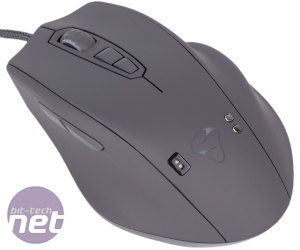
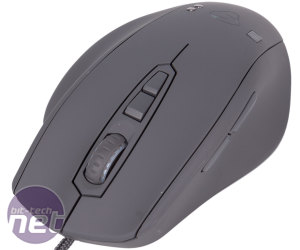
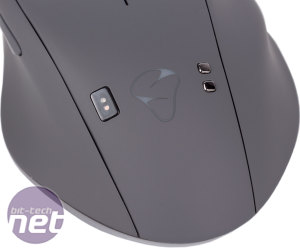
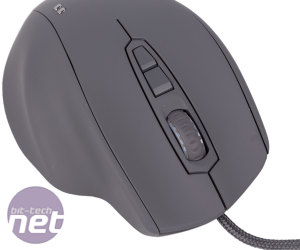

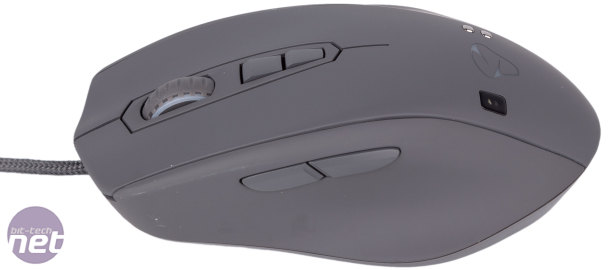
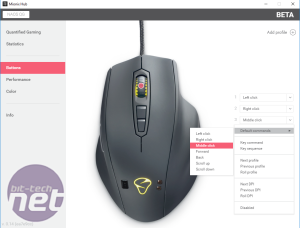
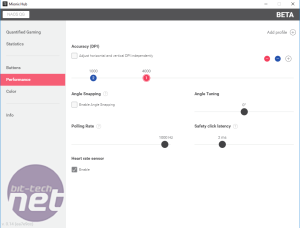







Want to comment? Please log in.